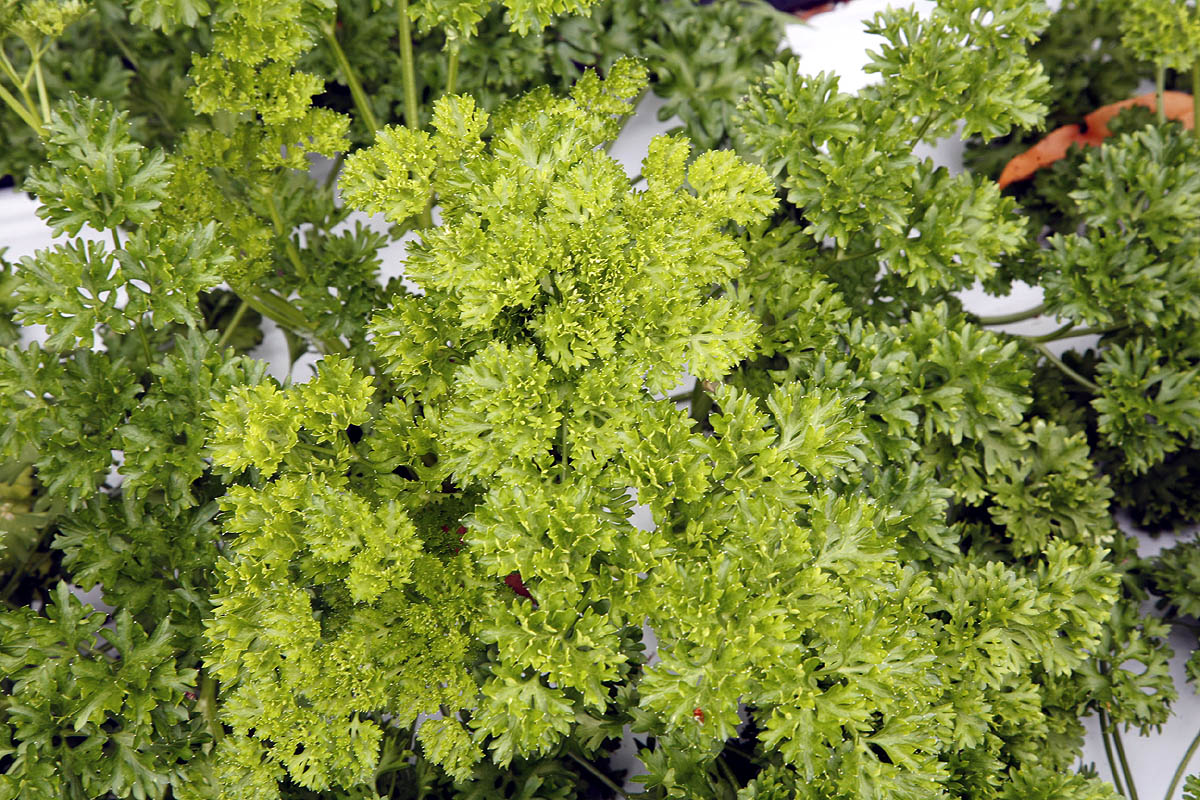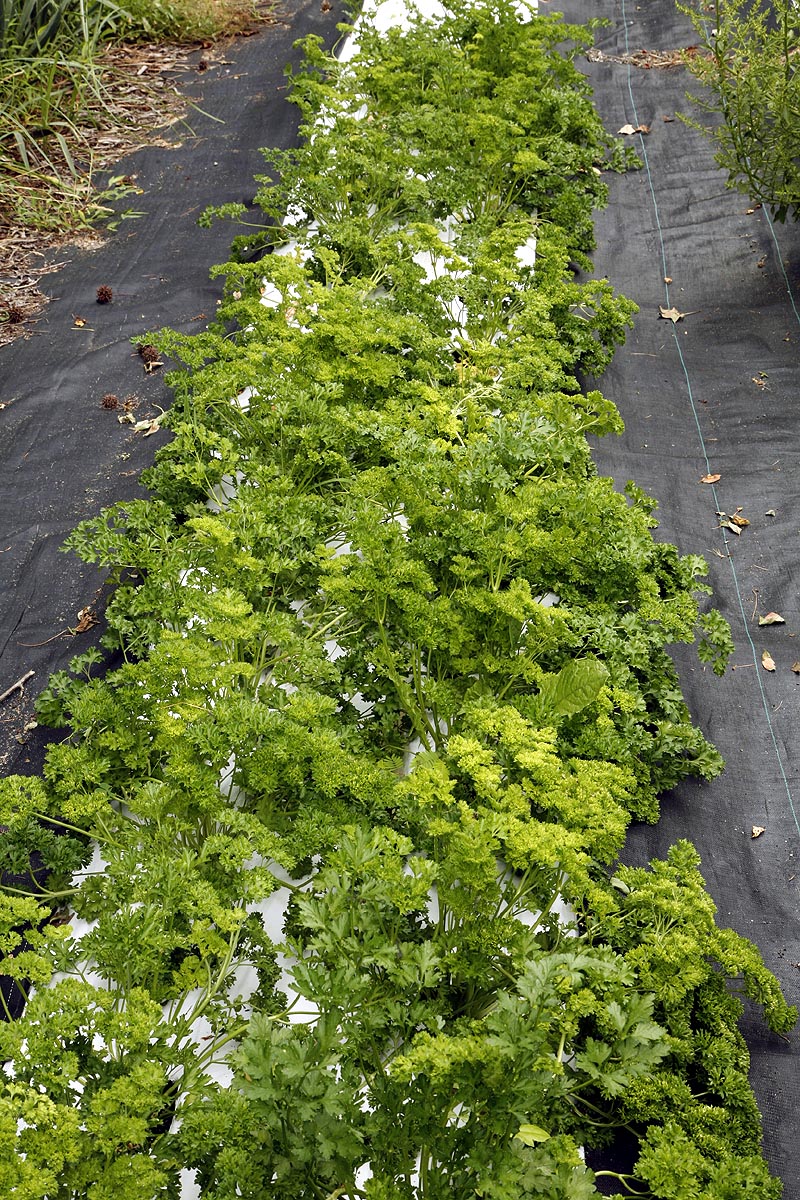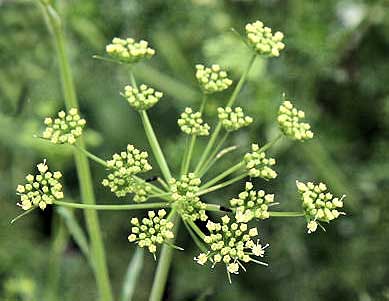No herb garden is really complete without parsley and the curly variety is especially attractive. It's lovely leaves are the choice of most chefs for garnish and visual and texture appeal in a meal. . The curly leaves add interest and texture in any garden bed mixed with flowering plants or alone as a pot plant on the deck or patio. Very easy to grow, mostly as an annual since it is harvested for its leaves it is extremely aromatic and left until its second year will produce white flowers that pollinators like. This plant is loved by humans and wildlife alike so it will need protection from being eaten. Parsley is also extremely rich in both Vitamin K and C. Its unique flavor is important in many dishes, salads and sauces.
Description of Triple Curled Parsley (Petroselinum crispum).
Parsley is a biennial herb meaning it flowers in the second year. In most cases it is grown as an annual and pulled up at the end of the season so the flowers are not often seen. In its first year it produces a rosette of triangular leaves made up of three leaflets (it's called tripinnate) which are darkish green in color. In this variety are very curled making them very attractive. Plants can reach about 12 inches (30 cm) in height and spread to about 16 inches (40.5cm) across.
In zones below 7b some of the leaves may overwinter and stay green, in the spring of the second year it will at first produce lush leaves but quickly puts forth tall thin tough stems which are topped with umbels of tiny white to greenish yellow flowers in June to August. The stems can reach 2 feet (61 cm) in height and appear delicate and fine even though the stems are tough. At this point the leaves turn bitter and a not useful in cooking.
Growing Triple Curled Parsley (Petroselinum crispum) from seed.
Parsley seeds are notoriously slow to germinate and can take anywhere from 2-5 weeks. Soaking the seeds overnight in tepid water before planting can help. It also needs warm soil for best germination rates. Due to the slow germination seeding in flats or individual pots indoors is recommended to reduce weeding and create strong plants for early harvesting. Start seeds about 6-8 weeks before the last frost date indoors or direct sow after frost danger has passed. Only lightly cover the seeds and keep them moist. Seedlings look more like grass when the do emerge and are slow to begin with. Transplant into individual pots as they grow past the four leaf stage and grow on before transplanting outside. Space plants 10-12 inches (25-30 cm) apart. For more details on growing seeds see our
General Growing Instructions.
Location and Care of Triple Curled Parsley (Petroselinum crispum).
Parsley does best when planted in a sunny location but it can tolerate some light shade. It prefers well drained soil with a high level of organic material to produce good lush leaves. It will grow on poorer soils but the leaves will not be as good. It cannot easily tolerate wet soils. It prefers a pH range from 5.0 - 7.0.
Plants like to be moist so try not to let the soil dry out completely, trickle irrigation (soaker hose) is ideal for parsley. Adding a light mulch or ground up leaves mixed with grass clippings can help keep the moisture in the soil around the plants. Don't use grass clippings alone they can pack down into a pancake and encourage mold. Fertilize with high nitrogen fertilizer and side dress with compost mid season to keep the leaves lush and green.
Parsley is also an excellent pot plant either for the deck, patio or as a houseplant. Its attractive foliage makes it a great filler or accent plant for almost any flower. Indoors it will need a bright location indoors and a south facing window is best and the plants may be a little spindly with lower light levels.
Companion planting
Parsley can help the growth of both roses and tomatoes.
Which Parsley? Straight or Curly the Great Debate.
There are two main species of Parsley
Italian flat-leaf (Petroselinum neapolitanum) and
Triple Curled,
(Petroselinum crispum). Both contain the same compounds that give parsley its unique flavor, its called menthatriene. While many claim one is more flavorful than the other its mostly due to when the leaves are harvested. Flat parsley has higher concentrations of menthatriene in the young leaves but as they mature it amount is reduced giving the leaves a more woody taste. Curly is the exact opposite with lower concentrations in young leaves and higher in the more mature ones. So when you harvest your parsley leaves will have a lot to do with how it tastes. Each also have different properties in that Curly leaves are thicker and more durable so they stand up better in some cooked dishes and have a distinct texture while flat is, well flat and tends to break up in cooked dishes. Curly is also considered more attractive visually so is most commonly used as a garnish or in eclectic salads where it produces more texture as well as strong flavor. What you use may depend on ethnic tradition but perhaps some consideration as to how you want your parsley to perform should be the most important factor.
So they are two different species right?
No they are not. In fact they are both
(Petroselinum crispum) but
Italian flat leaf is a variety of parsley the name is more correctly, and botanically listed as
(Petroselinum crispum var neapolitanum). But most just list it as
(Petroselinum neapolitanum) because its easier and quicker to distinguish.
Harvesting Triple Curled Parsley (Petroselinum crispum).
Leaves can be harvested from the plant as soon as it reaches about six inches in height. Leaves will be mild in flavor if harvested young and stronger when more mature. Snip each leaf close to the ground to encourage more growth and take only about one third of the plant at a time to ensure there are enough leaves to help the plant regenerate. In this way the leaves can be harvested all season. Taking just the leaf and leaving the stalk creates a less productive plant. If you leave the plants in place over the winter you can harvest the leaves in the early spring until the plant begins to send out flower stalks, at this point either let it seed or remove the plant.
Storing
Parsley leaves can be dried either on racks or in a dehydrator and stored for later use. Store in air tight containers away from the light. They can also be frozen in small bunches and kept in the freezer for up to a year.
Culinary uses of Triple Curled Parsley (Petroselinum crispum).
So many dishes, sauces and salads use parsley there are innumerable uses. Its one of the most commonly used herbs its very nutritious being high in Vitamin K and C and contains smaller amounts of many other vitamins and possibly minerals*.
Medicinal uses of Triple Curled Parsley (Petroselinum crispum).
Considered the best plant for use as natural vitamin supplement due to high levels of Vitamin C and K with a whole range of other vitamins and possibly minerals* in lesser amounts. Parsley is an excellent detoxifier helping the body excrete toxins via the urine. This makes it extremely useful for a whole range of issues including Rheumatism, cystitis, removing kidney stones, helping to dissolve and remove mineral buildups in the blood vessels and toning the kidneys. Some research has suggested it may be useful in treating certain types of cancer. In larger dosages parsley is a mild diuretic and laxative and is useful in treating anemia.
Caution.
It should not be taken in large dosages by pregnant women as it can stimulate menstrual flow and may cause miscarriage. The essential oil should be approached with great caution and never taken internally as it can cause liver and kidney damage, nerve inflammation and gastro-intestinal haemorrhage. This is certainly a case of more is not a good thing.
*Mineral content in any plant can only be as good as the mineral content in the soil. Plants cannot make minerals they can only extract and concentrate them. If the mineral is not in the soil its cannot be in the plant. Sadly so many soils are now depleted of minerals that are not replaced by general commercial agriculture so unless the plant is grown organically or using sustainable farming methods that care for the soil then the plant will be deficient in these minerals.








